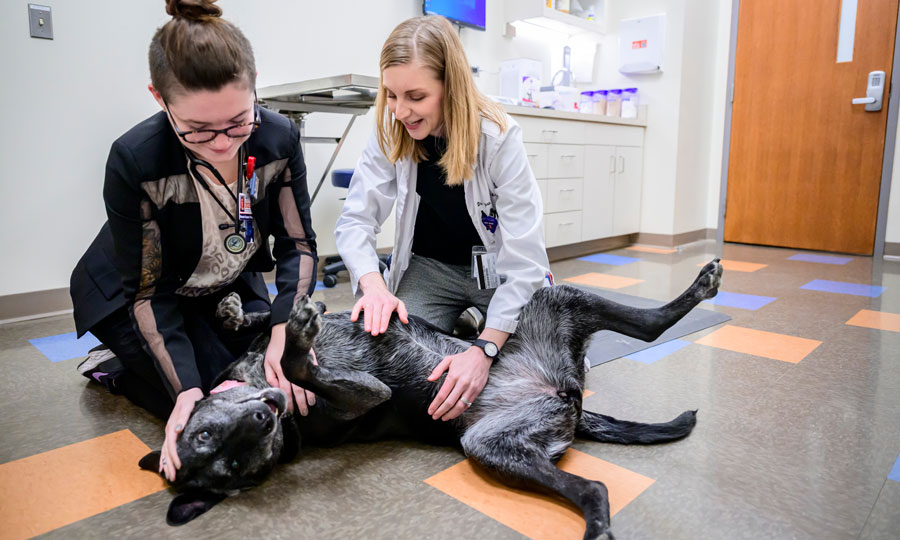The right environment, diet for your reptile
According to the most recent statistics for pet ownership in the United States, 4.7 million households kept 9.4 million reptiles as pets in 2016.
![[Dr. Sarah Reich weighs an owl]](https://vetmed.illinois.edu/wp-content/uploads/2021/04/pc-reich-wmc-300x240.jpg)
With the interest in reptiles as pets expanding, Dr. Sarah Reich, a veterinarian who sees wildlife and exotic pets at the University of Illinois College of Veterinary Medicine, has some advice for current or prospective reptile owners.
Know Your Reptile
“Ideally, people will seek out information before they acquire their pet so that they have the appropriate environment in which to house their new pet,” she explains. “It’s also important for owners to understand the costs involved in caring for their pet, especially as they age.”
Having the correct housing, nutrition, and care is vital to the well-being of reptile pets. All of these factors to consider fall under the term ‘husbandry’. Unfortunately, when some basic husbandry needs go unmet, the reptile will suffer the consequences. According to Dr. Reich, the exotics service at the college’s Veterinary Teaching Hospital in Urbana frequently sees these pets with problems.
“In a large number of cases, when a reptile is brought in for assessment, an underlying husbandry issue can be found,” explains Dr. Reich. Two common diseases seen in reptiles are nutritional secondary hyperparathyroidism and dysecdysis, and both of them can be caused by husbandry issues.
Nutritional Secondary Hyperparathyroidism
Nutritional secondary hyperparathyroidism (NSHP), often termed “metabolic bone disease”, is usually caused by either inappropriate lighting or an inappropriate diet.
“These guys can come in with pathologic fractures, meaning their bones are so weak and under-calcified that they break. They can also come in with spinal malformations or shell deformities, which usually developed from poor husbandry practices while the animal was still growing,” she says.
“The absence of UVB lighting is one reason that pet reptiles can develop nutritional secondary hyperparathyroidism. UVB light is necessary for the conversion of vitamin D in the body in many reptile species, which is important for calcium metabolism,” she explains. In reptiles as in people, calcium contributes to strong, healthy bones.
A lack of or imbalanced calcium in the diet is another factor that could lead to nutritional secondary hyperparathyroidism. Owners may choose diets that do not have the vitamins and minerals needed by their reptile species, or they may not be supplementing as needed.
“A species that people frequently do not provide adequate husbandry for is the iguana. Many people think that iguanas are carnivorous because they have pointy teeth, but iguanas are actually herbivores. Their diets should include big leafy greens and salads,” says Dr. Reich. “They also grow quite large, which can make providing an enclosure or habitat with UVB lighting difficult.”
Dysecdysis
Another husbandry-related reptile illness frequently seen at the Veterinary Teaching Hospital is dysecdysis. “In a normal reptile, shedding is called ecdysis,” says Dr. Reich. “Dysecdysis is characterized by an animal retaining a shed, possibly multiple layers if it has been an ongoing problem.”
“This can cause damage to the underlying scales and tissue to the point that the animal may never have a normal shed again,” explains Dr. Reich.
The main cause of this problem, according to Dr. Reich, is improper humidity levels. “Most of the time, the problems arises because humidity is too low for the reptile,” she says. “Even desert species need an appropriate level of humidity.”
Luckily, there are numerous ways to limit this problem from occurring. There are multiple water drip and mist systems commercially available for reptile owners. “One other way to counter dysecdysis is as straightforward as buying a humidifier for the room a reptile is housed in,” says Dr. Reich.
Veterinary Advice
“Husbandry problems are easy to avoid if you have the necessary tools and resources,” says Dr. Reich. She recommends that owners visit an exotics veterinarian to learn the correct information on housing, diet, lighting, humidity, and so on for their species of reptile.
“When you understand how to take care of your reptile, you can have a happy and healthy pet for years, and potentially decades,” concludes Dr. Reich.
By Hanna Netisingha

![[reptile - iguana]](https://vetmed.illinois.edu/wp-content/uploads/2021/04/pc-reich-reptile.jpg)


